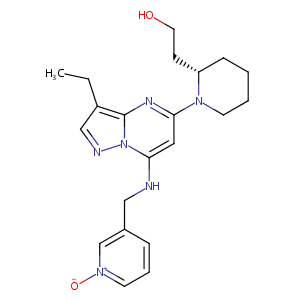Details of the Drug Combination
General Information of Drug Combination (ID: DC4SLL5)
| Drug Combination Name |
Armodafinil SCH 727965
|
|||||||||||||||||
|---|---|---|---|---|---|---|---|---|---|---|---|---|---|---|---|---|---|---|
| Indication |
|
|||||||||||||||||
| Component Drugs | Armodafinil | SCH 727965 | ||||||||||||||||
| Small molecular drug | Small molecular drug | |||||||||||||||||

|

|
|||||||||||||||||
| 2D MOL | 2D MOL | |||||||||||||||||
| 3D MOL | 3D MOL | |||||||||||||||||
| High-throughput Screening Result | Testing Cell Line: KBM-7 | |||||||||||||||||
| Zero Interaction Potency (ZIP) Score: 6.18 | ||||||||||||||||||
| Bliss Independence Score: 6.18 | ||||||||||||||||||
| Loewe Additivity Score: 18.44 | ||||||||||||||||||
| LHighest Single Agent (HSA) Score: 18.45 | ||||||||||||||||||
Molecular Interaction Atlas of This Drug Combination
| Molecular Interaction Atlas (MIA) | |||||||||||||||||||||||||||||||||||||||||||||||||||||||||||||
|---|---|---|---|---|---|---|---|---|---|---|---|---|---|---|---|---|---|---|---|---|---|---|---|---|---|---|---|---|---|---|---|---|---|---|---|---|---|---|---|---|---|---|---|---|---|---|---|---|---|---|---|---|---|---|---|---|---|---|---|---|---|
| Indication(s) of Armodafinil |
|
||||||||||||||||||||||||||||||||||||||||||||||||||||||||||||
|
Armodafinil Interacts with 1 DTT Molecule(s)
|
|||||||||||||||||||||||||||||||||||||||||||||||||||||||||||||
|
Armodafinil Interacts with 2 DME Molecule(s)
|
|||||||||||||||||||||||||||||||||||||||||||||||||||||||||||||
| Indication(s) of SCH 727965 |
|
||||||||||||||||||||||||||||||||||||||||||||||||||||||||||||
|
SCH 727965 Interacts with 3 DTT Molecule(s)
|
|||||||||||||||||||||||||||||||||||||||||||||||||||||||||||||
|
SCH 727965 Interacts with 7 DOT Molecule(s)
|
|||||||||||||||||||||||||||||||||||||||||||||||||||||||||||||
References
